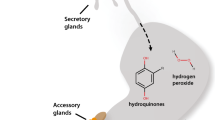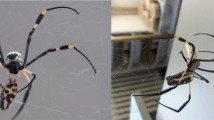Abstract
The defensive secretion of the lubber grasshopper,Romalea microptera, shows extreme chemical variation among individual adults of the same sex within a single wild population. Certain phenolic compounds were absent in some individuals and present in others. Concentrations of compounds, when present, varied over two to three orders of magnitude. Chemical variation attributable to individuals accounted for 60–88% of the total quantitative variation and was evenly contributed by all individuals in both sexes. Cluster and regression analyses showed no discernible predictable patterns in the defensive secretion variation. The specificity of chemical cues used by predators may explain why these defenses are so idiosyncratic.
Similar content being viewed by others
References
Berger, R.S. 1976. 2,5-Dichlorophenol: Not synthesized by the Eastern lubber grasshopper.Ann. Entomol. Soc. Am. 69:1–2.
Blum, M.S. 1974. Deciphering the communicative Rosetta stone.Bull. Entomol. Soc. Am. 20:30–35.
Blum, M.S. 1981. Chemical Defenses of Arthropods. Academic Press, New York, 502 pp.
Brower, L.P., andBrower, J. van Zandt. 1964. Birds, butterflies and poisons: A study in ecological chemistry.Zoologica 49:137–159.
Brower, L.P., Seiber, J.N., Nelson, C.J., Lynch, S.P., andTuskes, P.M. 1982. Plant-determined variation in the cardenolide content, thin-layer chromatography profiles and emetic potency of monarch butterflies,Danaus plexippus L., reared on the milkweed,Asclepias eriocarpa in California.J. Chem. Ecol. 8:579–634.
Brower, L.P., Seiber, J.N., Nelson, C.J., Lynch, S.P., andHolland, M.M. 1984. Plant-determined variation in the cardenolide content, thin-layer chromatography profiles and emetic potency of monarch butterflies,Danaus plexippus L. reared on milkweed plants in California. 2.Asclepias speciosa.J. Chem. Ecol. 10:601–640.
Daloze, D., andPasteels, J.M. 1979. Production of cardiac glycosides by chrysomelid beetles and larvae.J. Chem. Ecol. 5:63–77.
Denno, R.F., andMcClure, M.S. (eds.). 1983. Variable Plants and Herbivores in Natural and Managed Systems. Academic Press, New York, 717 pp.
Doyen, J.T. 1973. Systematics of the genusColocnemis (Coleoptera: Tenebrionidae). A quantitative study of variation.Univ. Calif. Publ. Entomol. 73:1–110.
Eisner, H.E., Alsop, D.W., andEisner, T. 1967. Defense mechanisms of arthropods. XX. Quantitative assessment of hydrogen cyanide production in two species of millipedes.Psyche 74:107–117.
Eisner, T., Hendry, L.B., Peakall, D.B., andMeinwald, J. 1971. 2,5-Dichlorophenol (from ingested herbicide?) in defensive secretion of grasshopper.Science 172:277–278.
Goh, S.H., Chuah, C.H., Tho, Y.P., andPrestwich, G.D. 1984. Extreme intraspecific chemical variability in soldier defense secretions of allopatric and sympatric colonies.J. Chem. Ecol. 10:929–944.
Jones, C.G. 1983. Phytochemical variation, colonization and insect communities: The case of bracken fern (Pteridium aquilinutri), pp. 513–558in R.F. Denno and M.S. McClure (eds.). Variable Plants and Herbivores in Natural and Managed Systems. Academic Press, New York.
Jones, C.G.,Whitman, D.W.,Compton, S.C.,Silk, P.J., andBlum, M.S. 1986a. Dietary breadth changes the chemical defense of a grasshopper. In preparation.
Jones, G.G.,Hess, T.A.,Whitman, D.W.,Silk, P.J., andBlum, M.S. 1986b. Effects of diet breadth on autogenous chemical defense of a generalist grasshopper. Submitted.
Kevan, D.K.M. 1980.Romalea guttata (Houttyun), name change for well-known “Eastern lubber grasshopper” (Orthoptera: Romaleidae).Entomol. News 91:139–140.
Meinwald, J., andHendry, L. 1969. Defense mechanisms of arthorpods. XXV. Stereospecific synthesis of an allenic sesquiterpenoid from the grasshopperRomalea microptera.Tetrahedron Lett. 21:1657–1660.
Meinwald, J., Erickson, K., Hartshorn, M., Meinwald, Y.C., andEisner, T. 1968. Defensive mechanisms of arthropods. XXIII. An allenic sesquiterpenoid from the grasshopperRomalea microptera.Tetrahedron Lett. 25:2959–2962.
Owen, M.D. 1978. Venom replenishment as indicated by histamine, in honeybee (Apis melifera) venom.J. Insect Physiol. 24:433–438.
Pasteels, J.M., andGregoire, J.-C. 1984. Selective predation on chemically defended chrysomelid larvae. A conditioning process.J. Chem. Ecol. 10:1693–1700.
Pasteels, J.M., Gregoire, J.-C., andRowell-Rahier, M. 1983. The chemical ecology of defense in arthropods.Annu. Rev. Entomol. 28:263–289.
Prestwich, G.D. 1983. Chemical systematics of termite exocrine secretions.Annu. Rev. Ecol. Syst. 14:287–311.
Rothschild, M. 1973. Secondary plant substances and warning coloration in insects.Symp. R. Entomol. Soc. London 6:59–83.
Tricot, M.-C., Pasteels, J.M., andTursch, B. 1972. Pheromones stimulant et inhibitant l'aggressivité chezMyrmica rubra.J. Insect Physiol. 18:499–509.
Tschinkel, W.R. 1975. A comparative study of the chemical defensive system of tenebrionid beetles: Chemistry of the secretions.J. Insect Physiol. 21:753–783.
Wallbank, B.E., andWaterhouse, D.F. 1970. The defensive secretions ofPolyzosteria and related cockroaches.J. Insect Physiol. 16:2081–2096.
Whitman, D.W.,Jones, C.G., andBlum, M.S. 1986. Predator community responses to chemically defended grasshopper prey. In Preparation.
Whittaker, R.H., andFeeny, P.P. 1971. Allelochemics: Chemical interactions between species.Science 171:757–770.
Author information
Authors and Affiliations
Rights and permissions
About this article
Cite this article
Jones, C.G., Hess, T.A., Whitman, D.W. et al. Idiosyncratic variation in chemical defenses among individual generalist grasshoppers. J Chem Ecol 12, 749–761 (1986). https://doi.org/10.1007/BF01012107
Received:
Accepted:
Issue Date:
DOI: https://doi.org/10.1007/BF01012107




